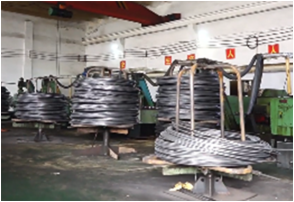Nov . 14, 2024 09:55 Back to list
high tensile threaded bar
High Tensile Threaded Bar A Vital Component in Modern Engineering
In today's fast-paced construction and manufacturing industries, the quest for stronger, more reliable materials has led to the widespread adoption of high tensile threaded bars. These versatile and robust components play a critical role in various applications, ensuring structural integrity and enhancing the durability of numerous projects. This article explores the characteristics, applications, manufacturing processes, and benefits of high tensile threaded bars in contemporary engineering.
Understanding High Tensile Threaded Bars
High tensile threaded bars are long, cylindrical bars made from high-strength steel, designed to withstand significant tensile stresses. The 'threaded' aspect refers to the helical ridges that are created along the bar's length, allowing for easy connection and interaction with nuts, bolts, and other fastening elements. The term 'high tensile' indicates that these bars possess superior strength characteristics, enabling them to perform effectively in demanding conditions.
Characteristics of High Tensile Threaded Bars
One of the defining features of high tensile threaded bars is their ultimate tensile strength (UTS). This strength level is significantly higher than that of standard steel bars, making them suitable for heavy-duty applications. Typically, the UTS of high tensile threaded bars ranges from 800 MPa to well over 1000 MPa, depending on the specific grade of the material used.
Moreover, these bars often exhibit excellent ductility, which allows them to deform under stress without fracturing. This property is crucial in construction, as it ensures that structures can endure dynamic loads (such as those from winds or earthquakes) without catastrophic failure.
The surface finish of high tensile threaded bars is also an important characteristic. They are often treated with protective coatings or corrosion-resistant materials to enhance their lifespan and maintain structural integrity in harsh environmental conditions.
Applications of High Tensile Threaded Bars
High tensile threaded bars find applications across various engineering sectors due to their strength, versatility, and reliability
. Some of the primary areas of use include1. Construction In the field of construction, these bars are used as tensioning elements in reinforced concrete structures. They are commonly employed in foundation systems, retaining walls, and bridge construction to help manage tensile forces effectively.
high tensile threaded bar

2. Geotechnical Engineering High tensile threaded bars are vital in soil stabilization methods, such as rock anchoring and soil nails. These bars help secure structures in place and prevent landslides or subsidence.
3. Manufacturing In industrial applications, high tensile threaded bars serve as tensioning devices for machinery, ensuring that components are securely fastened under high-pressure conditions.
4. Marine Engineering Given their resistance to corrosion, these bars are frequently used in marine applications, including anchoring ships and constructing offshore platforms, where they must withstand harsh environmental conditions.
Manufacturing Processes
The manufacturing of high tensile threaded bars involves several stages, including raw material selection, forging, threading, and heat treatment. High-quality steel is typically selected for its mechanical properties, followed by forging processes that shape the bars into their final form.
Threading is performed using advanced machinery to ensure precision and consistency across the entire bar length. Finally, a crucial step often involves heat treatment, which enhances the material's strength and fatigue resistance by altering its microstructural properties.
Benefits of High Tensile Threaded Bars
The advantages of utilizing high tensile threaded bars are manifold. Their superior strength-to-weight ratio allows engineers to design lighter structures without compromising safety. Additionally, their ease of installation and compatibility with various fastening systems streamlines construction processes, ultimately leading to reduced labor costs and time.
Moreover, the durability and corrosion resistance of these bars mean less maintenance and longer service lives, resulting in significant cost savings over time. In an era where sustainability and efficiency are paramount, high tensile threaded bars stand out as an innovative solution to meet the demands of modern engineering challenges.
Conclusion
High tensile threaded bars are an essential component in the engineering landscape, offering unparalleled strength and reliability for various applications. As industries continue to evolve, the demand for high-performance materials like these threaded bars will likely increase, ensuring that they remain at the forefront of construction and manufacturing techniques for years to come. Their ability to enhance structural integrity and withstand demanding conditions makes them a cornerstone of modern engineering solutions.


